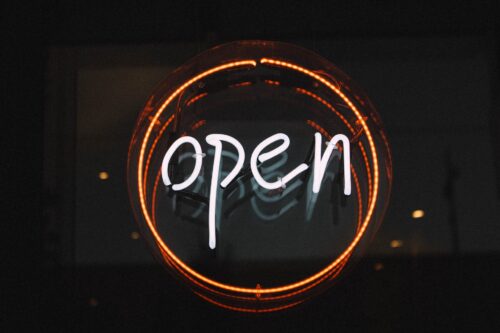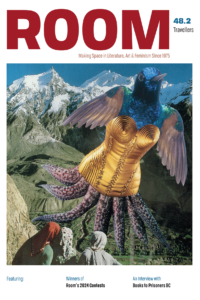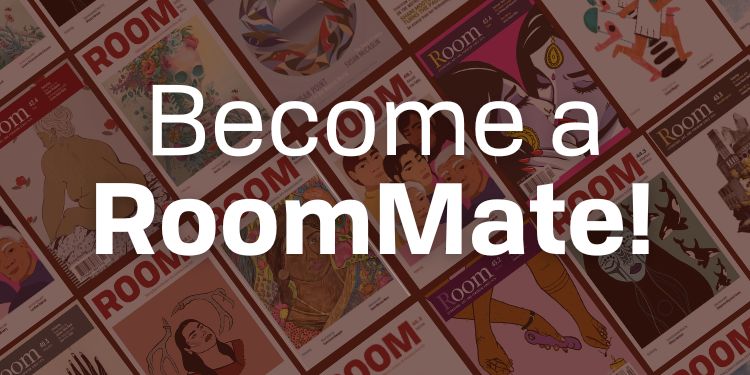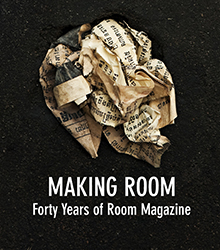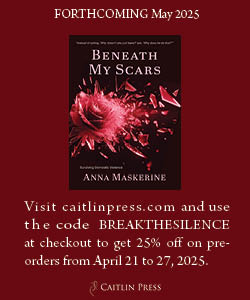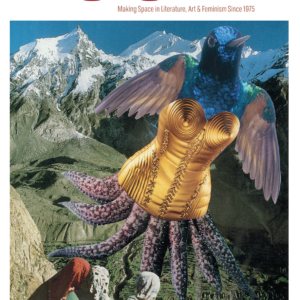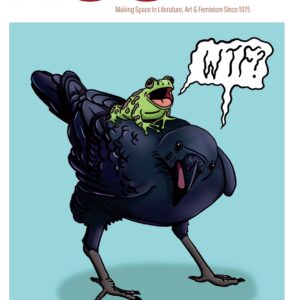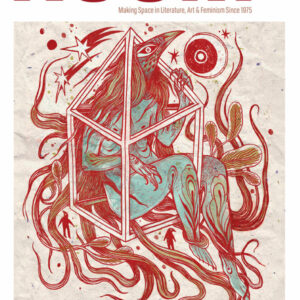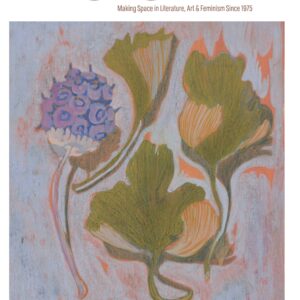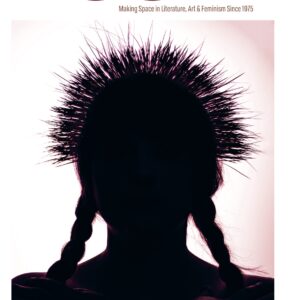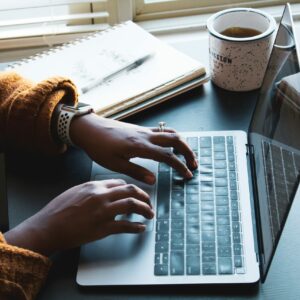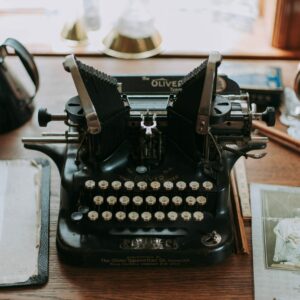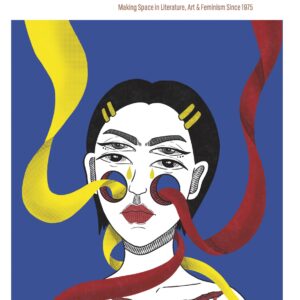ROOM: What excites you about working on this issue?
Angelica Poversky: This is my first time as an assistant editor. I am really humbled to work with our team, cause [they] make my spirit smile. I’m really excited to curate the issue with them, and create our little expansive world together. It feels like a limitless project in a gentle container.
Hope Lauterbach: I am excited for so many things. To read submissions, to shadow Selina and Angelica and work with Asna, and to watch the issue take shape through the process of curation and editing. Most of all, I am excited to hold the end project in my hands, and to celebrate the writers and artists within those pages.
Asna Shaikh: Working with this wonderful editorial team! All three of them—Angelica, Hope, Selina—are amazingly talented and their passion for writing, creativity and art is infectious. I’ve already learned so much from them and look forward to learning more. Oh, and I’m also excited about reading all the submissions!
Selina Boan: I feel so lucky to be working with such a passionate and thoughtful editorial team. It is my first time as the lead editor for a Room Issue and I have been so inspired by our team’s conversations about curating an open issue that considers how language opens possibilities.
Angelica’s vision for this open issue has been foundational and I am so excited to celebrate the incredible work of the artists and writers who submit.
ROOM: What are you looking for in submissions for this open issue?
AP: I am anchored through the idea of “open” to guide my process as I’m looking at submissions. How does language require opening? How do we give up all assumptions? How do we dig out definitions? How do we carve out new meaning in words? How do we hone in on such a deep specificity, that our phrases become infinite? How does precise form and strictness create containers for abundance?
HL: I am looking for writing that takes me by surprise. Sensory language that pulls me into the piece, and does not let go.
AS: Since this is an “open” issue, I want people to submit that piece that they think wouldn’t fit anywhere. If you’ve created something that’s strange and weird and provocative, but feel like you can’t find a place for it in the world, then please send it to us! We promise we will treat it with the love and care it deserves.
SB: I am looking for work that is unapologetic, tender, and surprising. For this issue, I will be looking for work that is unafraid to contradict itself or be messy. I am drawn to work that reveals something unexpected, that takes us to the gut of a feeling or moment.
ROOM: Do you have any advice or tips for preparing work for submission?
AP: I’m excited by work that is a process of discovery, where the poet used a poem as a process to learn, grow and come to a new understanding they did not have before they started the poem. Take us with you on this journey of openness!
HL: Know your intention for writing and submitting the piece, and take pride in the act of creation.
AS: I was recently given this advice regarding my own writing: don’t wait to submit your work. Don’t wait until you’ve been writing for a couple of years, or until you’ve amassed a small collection of pieces. If you want to see your writing in publications, submit as soon as you can. Of course, try to match the style/tone of your submission to the kind of work a magazine is known for publishing, but don’t waste time on thinking you’re not good enough to submit yet. Every writer makes a start somewhere, and this could be yours.
SB: I want to encourage you to trust the vision you have for your work. Trust that what excites or inspires you, will inspire someone else. In relation to submission logistics, I will always remember what a mentor of mine (Sandra Ridley) taught me about submission letters: keep them short and sweet. All you need is to list the titles you are submitting and your bio.
ROOM: What is one thing you would want the reader to take away from this issue?
AP: For folks to feel inspired to open up definitions, to feel curious about language and its possibilities.
HL: That through reading this issue they discover something new about themself.
AS: I want the reader to feel excited about all the talent that exists in our community right now—all these writers that pour themselves into their writing to create these beautiful moments of relation and identification with the reader. I love it when I read something and then have to stare into space for five minutes and let it wash over me, and I want the reader to have the same experience with this issue.
SB: My goal for this issue is to celebrate what art and writing can do: it can make us feel seen, it can encourage us to look at something differently, it can surprise and inspire. I want this issue to celebrate, support, and introduce readers to new writers and artists who are bringing that energy into the world right now.
ROOM: What is something you read / watched / listened to recently that moved you?
AP: I love Gina Goicco’s Loving Suits. She creates plus hand soft weighted sculptures in the shape of hands. They are stuffed with lavender, beads, and joy. She works with the hands to give care and nurturance back to her community, playing with radical tenderness. These sculptures are sculptures of embrace.
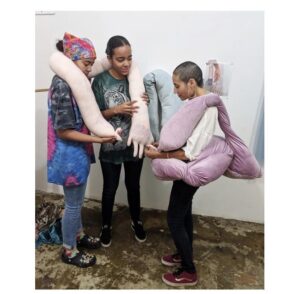
Photo by Gina Goicco
She contends with the ancestral as well as offering care and soothing to women and gender non-confirming people, which is a really powerful part of her work as an Afro-Indigenous Dominican artist in the Bronx.
I love this work because it empowers and creates communities of care. Especially right now, where a lot of folks are not getting the touch and in-person presence they need, I think this exploration creates new possibilities. It brings art right off the page and back into the body, with a vulnerable courage. A courage for compassion.
HL: I recently read the novel Earthlings written by Sayaka Murata, and translated to English by Ginny Tapley Takemori. It’s a masterful example of how character voice, structure and point of view can shape narrative into a devastatingly tender reading experience.
AS: Am I allowed to say Taylor Swift’s song “Willow?” Because Taylor Swift’s song “Willow.”
SB: I have been really inspired by the online beading community. The work by Kihew and Rose, Salia Joseph, L’Hirondelle, Lor Brand, Samantha Nock, Nalakwsis, Bronwyn Butterfield (and so many more!) is absolutely stunning. What these folks are able to do with beads floors me. I’ve also been really moved by Michelle Sound’s recent auntie series. I’m daydreaming about the day I can see her artwork in person.
ROOM: What’s one thing you’d like ROOM readers to know about you?
AP: I am a professional clown. My most famous clown is Gunky Gertrude. She/her pronouns. Loves fish. Hates gunk. It’s been a mess since she’s discovered IGTV.
HL: I used to collect Animorph books.
AS: I miss in-person literary gatherings. I miss being together in the same room with lovely people from the community, basking in their positive and galvanizing energy, and coming home buzzing with inspiration, motivation, and an amplification of my belief in the arts.
SB: I can be very goofy! It’s one of the reasons I love working with kids so much; they inspire me to be curious, to ask more questions, to pay attention, and to laugh more.
ROOM: What is a piece of advice or work of art that you remember opened something up for you or revealed a possibility?
AP: I was super honoured to learn and receive guidance from Kathy Engel in her course Language is Action. She told me about giving up assumptions in language; the work of the poet is to create new-ness, to challenge prescription. She gave me a lot of guidance around radical honesty, speaking our truth, and entering awe in our work. Digging into language. Allow the language to evolve and become. She also gave me amazing guidance on the uses of form, how does the poem look on the page? What do the line breaks and the spaces between words mean?
HL: After reading Steal Like An Artist by Austin Kleon, I was inspired by the life and process of creativity. I am inspired to learn more about what content others (not just artists) are consuming. What inspires them? What drew them to their artistic choices? You are what you read, what you watch, what you consume. I’m inspired by how communities are born from an idea, how we choose or choose not to connect.
AS: I don’t remember where I read this, but the advice is to live your life with intention. So much of what we do in our busy lives and busy minds is bereft of deliberate and clear intention; at least this is true for me. I’m trying now to have a clear sense of purpose behind whatever I choose to do, whether it be writing or spending time with a friend or cooking or reading submissions. The intention doesn’t have to be good, or even valid. It simply needs to exist as a conscious force behind an action. In a way, it’s about wielding language to articulate the dimensions of your life, so that the possibilities to open up to more (or less) present themselves.
SB: I always come back to a question that the poet Natalie Diaz asked herself: how can I be more possible? This question floored me and it remains written on a post-it note in my room where I work. Asking questions of ourselves and our work is a crucial tool for writers and it is a lesson I have carried with me.
ROOM: What are your perspectives on how form and containers can create openness ?
AP: Sometimes the work of form creates inexplicable infinites. Golden is another poet I admire from afar. They consistently use forms of repetition, of mirroring, of template work—forming ideas of the poem into the medium itself. This is work that creates deep space for emotions to live out fully.
HL: A container invites me to fill the space as creatively as I can, therefore opening myself to new ways of shaping language.
AS: I think openness, as an abstract concept, can be difficult to grasp on its own. I love working with contradictions; a form (or a container) makes it easier to think about everything it doesn’t contain, everything it leaves out. I think once you familiarize yourself with the limitations of the form you’re working with, be it a form of writing or a form of identity, then it gives you a jumping-off point to explore beyond it, to find more of yourself outside of the form.
SB: This question makes me think about my experiences with writer’s block. There are times when the blank page feels intimidating and unapproachable. In those moments, I will often turn to a form or prompt that contains the work in some way (be it a word pool or a first sentence) as a jumping-off point. Working under these constraints has helped me feel freed up to explore.
ROOM: How is language action for you?
AP: This one quote says it all for me: “What would happen if one woman told the truth about her life? The world would split open.” Muriel Rukeyser wrote that in 1968.
HL: Words carry tremendous power, and playing with language is a door to knowing ourselves better. Language as action is growth.
AS: On a deeply personal level, the English language specifically has been a major driver in my life. As someone who received it as a second language and made it my native tongue, I experience language as an active agent of change. It’s the vehicle through which I navigate my family’s culture, my entrenchment in Western culture, and how I mesh these two together to create my own sense of cultural identity. Just by the mere act and audacity of speaking English, I am irrevocably a different person than the one I would’ve been if I’d never acquired it.
SB: These are incredible responses and make me think about my own relationship to language learning. I am currently learning nêhiyawêwin and it is an empowering, challenging, and slow process. When I think about language as an action, I am inspired by what language reveals about our worldviews and the knowledge that it transfers. As Hope said, language holds an immense amount of power.
